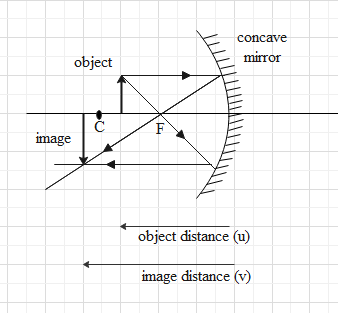
A mirror forms a real image of an object placed in front of it. Name the kind of mirror.
A. concave
B. convex
C. plain mirror
D. all of the above
Answer
576.3k+ views
Hint: Define the process of image formation for different kinds of mirrors. The properties of the image formed due to a certain mirror will depend on the type of the mirror and the position of the objects in front of the mirror. From the above discussion we can give our answer to this question.
Complete step by step answer:
The type or the property of the image formed due to a mirror is dependent on the type of the mirror and the position of the object in front of the mirror.
Different types of mirror produce different types of images. Again, the position of the object in front of the mirror also determines the properties of the images. Now, convex mirrors always produce virtual images and concave mirrors produce both the real and virtual images depending on the position of the object. Again, plane mirrors also produce only virtual images.

Now, for concave mirror-
When we place the object at infinite distance, the image will be formed at the focal point and the image will be real, inverted and diminished.
When we place the object beyond the centre of curvature, the image will be formed between the focal point and the centre of curvature and the image will be real, inverted and diminished.
When we place the object at the centre of curvature, the image will be formed at the centre of curvature and the image will be real, inverted and the same size as the object.
When we place the object between the centre of curvature and the focal point, the image will be formed beyond the centre of curvature and the image will be real, inverted and magnified.
If the object is placed at the focal point, the image will be formed at infinite distance and the image will be real, inverted and magnified.
If the object is placed between the pole and the focal point, then the image will be formed behind the mirror and will be virtual, erect and magnified.
So, only for concave mirrors we will get real images.
So, the correct answer is “Option A”.
Note: The real images can be formed only for concave mirrors but the virtual images can be formed in all the types of mirrors. Concave mirror, convex mirror and the plane mirror- in all of them we will get virtual images.
Complete step by step answer:
The type or the property of the image formed due to a mirror is dependent on the type of the mirror and the position of the object in front of the mirror.
Different types of mirror produce different types of images. Again, the position of the object in front of the mirror also determines the properties of the images. Now, convex mirrors always produce virtual images and concave mirrors produce both the real and virtual images depending on the position of the object. Again, plane mirrors also produce only virtual images.

Now, for concave mirror-
When we place the object at infinite distance, the image will be formed at the focal point and the image will be real, inverted and diminished.
When we place the object beyond the centre of curvature, the image will be formed between the focal point and the centre of curvature and the image will be real, inverted and diminished.
When we place the object at the centre of curvature, the image will be formed at the centre of curvature and the image will be real, inverted and the same size as the object.
When we place the object between the centre of curvature and the focal point, the image will be formed beyond the centre of curvature and the image will be real, inverted and magnified.
If the object is placed at the focal point, the image will be formed at infinite distance and the image will be real, inverted and magnified.
If the object is placed between the pole and the focal point, then the image will be formed behind the mirror and will be virtual, erect and magnified.
So, only for concave mirrors we will get real images.
So, the correct answer is “Option A”.
Note: The real images can be formed only for concave mirrors but the virtual images can be formed in all the types of mirrors. Concave mirror, convex mirror and the plane mirror- in all of them we will get virtual images.
Recently Updated Pages
Basicity of sulphurous acid and sulphuric acid are

Master Class 12 Business Studies: Engaging Questions & Answers for Success

Master Class 12 Economics: Engaging Questions & Answers for Success

Master Class 12 English: Engaging Questions & Answers for Success

Master Class 12 Maths: Engaging Questions & Answers for Success

Master Class 12 Social Science: Engaging Questions & Answers for Success

Trending doubts
What are the major means of transport Explain each class 12 social science CBSE

Which are the Top 10 Largest Countries of the World?

Draw a labelled sketch of the human eye class 12 physics CBSE

How much time does it take to bleed after eating p class 12 biology CBSE

Explain sex determination in humans with line diag class 12 biology CBSE

Differentiate between homogeneous and heterogeneous class 12 chemistry CBSE




